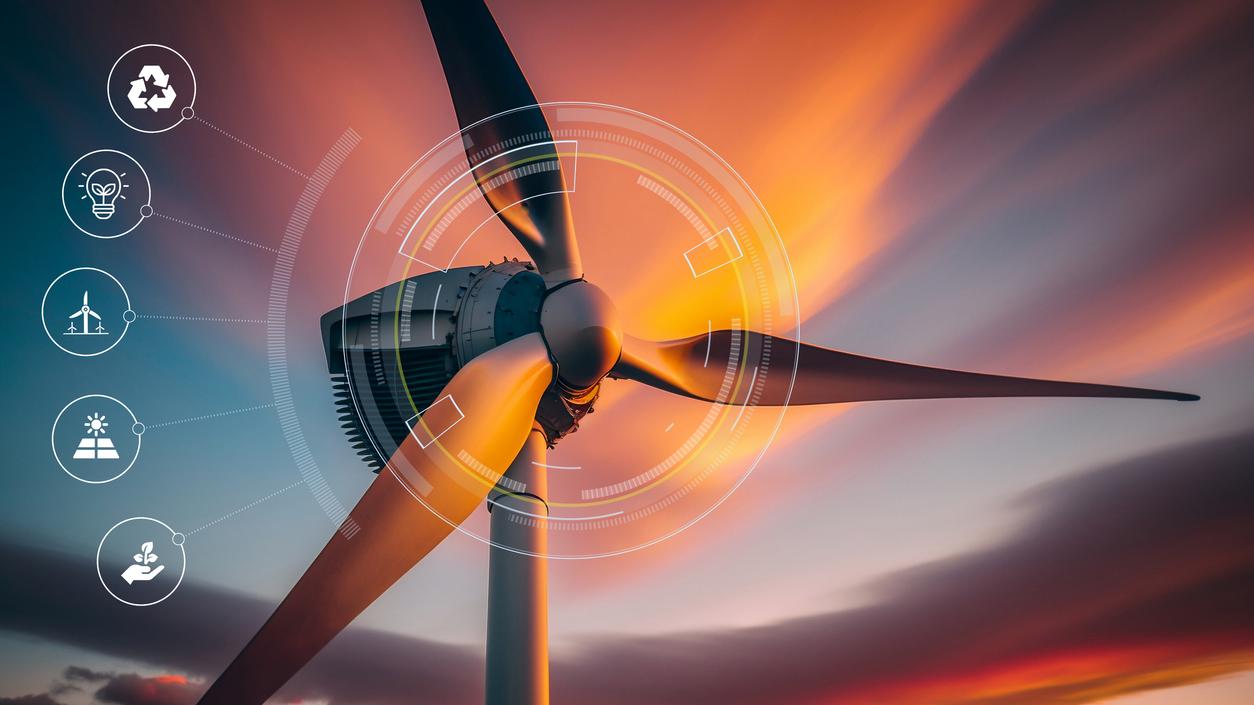
Mining on the Moon for Sustainable Energy
-
bookmark
-
print
Helium-3 is an important isotope for technological and energy innovation driving the net-zero transition. It's very rare on Earth but found commonly on the Moon. In the latest episode of Sustainability Leaders, Michael Torrance, Chief Sustainability Officer at BMO, sits down with Glen Martin, Chief Executive Officer of The Extraterrestrial Mining Company (XMC), to discuss mining Helium-3 on the Moon and how space exploration will be part of the energy transition on Earth.
Sustainability Leaders podcast is live on all major channels, including Apple and Spotify.
Glen Martin:
I think it's important for everyone to realize that this is not science fiction. This is actually happening today. These are technologies that have flown and been proven, and samples are coming back from the Moon already.
Michael Torrance:
Welcome to Sustainability Leaders. I'm Michael Torrance, Chief Sustainability Officer at BMO. On this show, we will talk with leading sustainability practitioners from the corporate, investor, academic, and NGO communities to explore how this rapidly evolving field of sustainability is impacting global investment, business practices, and our world.
Disclosure:
The views expressed here are those of the participants and not those of Bank of Montreal, its affiliates or subsidiaries.
Michael Torrance:
Glen Martin is Chief Executive Officer of The Extraterrestrial Mining Company, XMC. Glen's career has had a unique trajectory working on space technology and renewable energy. His current company is focused on addressing the challenge of mining helium-3 on the Moon, a rare isotope that will be an ingredient for emerging clean energy technology here on Earth.
In our discussion, Glen will explain why helium-3 is important for technological and energy innovation and its potential to impact the net zero transition and to show how space exploration will support the energy transition here on Earth. Glen, thanks for joining us today.
Glen Martin:
It's my absolute pleasure, Michael. Thank you for having me on your amazing podcast.
Michael Torrance:
Why don't we start with your background, Glen? What was your journey to get to this point of starting XMC and how did the work that you've done up until now lead you to do what you're doing?
Glen Martin:
Well, I started as a young Canadian aerospace engineer, trained in Toronto, worked at both Rolls-Royce in Montreal and then later at De Havilland Canada in Toronto on the Dash-8 series. Moved to California in 1990 to work on the International Space Station as a designer and got to work very closely with the astronauts there on very large scale space infrastructure.
After grad school at USC, I went to work at Hughes Space and Comm, where I met a group of individuals that I very much got along with when we had a lot of very common vision. And we spun out a startup company called ProtoStar working on launching satellites over Asia. This company was successful. We bought and launched two satellites serving India and Indonesia respectively, and got to work in the entrepreneurial space environment in the late 2000 timeframe.
And part of that journey then later was I got a call from my folks at Huntington Beach where we'd worked together on advanced projects with the Phantom Works organization, which McDonnell Douglas later became Boeing, and they asked me if I wouldn't mind terribly breaking into the terrestrial solar market to work with them. And I did. I went to Ontario.
I developed an extraordinarily large solar plant, almost 500 acres of solar power plant, and sold it in 2011 and really cut my teeth on project financing. And so in returning to the space industry, I thought that a lot of what was happening in the commercial space industry and the lowering of launch costs would create an opportunity for deployment of very large scale space infrastructure, particularly mining, which is really going to be the first commercial activity off world.
And so started looking at ways to project finance large scale infrastructure mining assets, particularly for helium-3. So that is the genesis of the foundation of The Extraterrestrial Mining Company.
Michael Torrance:
It's so interesting and your background is so deep in both the space sector and in renewable energy. Can you describe for the audience what is the connection in your mind between space mining and clean energy?
Glen Martin:
The helium-3 isotope that you mentioned in the introduction is the critical element. It is an extraordinarily useful versatile isotope. It's very rare here on Earth. The helium-3 is something like 0.0001% of naturally occurring helium, and it's useful for both fusion power. So at a billion degrees Kelvin, two helium-3 atoms will fuse and create a burst of energy without creating radioactive waste.
So it's the gold standard of the fusion industry as it emerges into commercial deployments. And then interestingly, at the other end of the spectrum, it is the best refrigerant that we have available to us. It can actually take the temperature of an enclosed space down below 10 millikelvin, which it turns out is critical path for things like quantum computers to keep their qubits from decohering or disentangling.
And so helium-3 is used as refrigerant in the quantum industry. There, again, large deployments of quantum data centers are happening right now and there isn't enough helium-3 on planet Earth.
Michael Torrance:
Tell us a little bit about how helium-3 is acquired on Earth right now.
Glen Martin:
Today it primarily comes from the decay of tritium, which is an isotope of hydrogen. In the United States, it comes primarily from the decay of tritium in the nuclear warheads. The thermonuclear weapons have tritium as their weapons grade material in the warheads. And over 12 and three-quarter years, that decays into helium-3. And so the canisters have to be removed periodically where they vent the gases, the tritium gas and helium-3 gas, and they extract and separate the helium-3 gas.
In so doing, they produce on the order of 10 to 15 kilograms of helium-3 per year. We may a reserve on the order of 29 kilograms a year. And interestingly, Canada produces around two kilograms a year from its deuterium uranium fleet, which, interestingly, produces tritium as a byproduct. So it's a precious resource.
The market today is primarily going to neutron detectors, but the Department of Homeland Security turns out to be a very good substance for absorbing neutrons and telling if there is material in a shipping container as an example. And actually interestingly also for medical applications, you can inhale it. It's a good marker for magnetic resonance imaging.
Michael Torrance:
Glen, what do you think will be the effect on Earthly greenhouse gas emissions related to the types of technology that you're able to support with helium-3?
Glen Martin:
Well, the big impact on greenhouse gas reduction is going to be really in the fusion area. McKinsey study that we saw says fusion will probably take on the order 46% of the supply mix globally as we have to double the amount of electricity that we generate from green sources. Seven terawatts is really what we anticipate will be built out by 2050, and that seven terawatts will reduce the greenhouse gas emissions globally by 27 teratons. And so it's an extraordinary amount of reduced pollution that's going into the atmosphere of the Earth and substantially reduce global warming.
Michael Torrance:
Glen, how do you see the growth of fusion and quantum computing, the two things that you mentioned, will be the drivers for demand?
Glen Martin:
Well, in deep conversations with the fusion industry, we're a member of the Fusion Industry Association, in discussions with a lot of the quantum data center operators like IBM and Amazon and Microsoft and Google, it turns out that the 10 to 15 kilograms that we produce a year are going to be desperately short of the demand. The current market is roughly two kilograms just for quantum.
And so they anticipate this may be three to 400 kilograms per year in the next 10 years. And in the case of fusion, it is 100 times as much demand. So according to some analyses done by McKinsey, by 2050, we may be consuming on the order of 357,000 kilograms of helium-3 a year in fusion reactors that will be using helium-3 in their fuel cycle. So we're desperately short and we do not produce anywhere near enough of what we're going to need.
Michael Torrance:
So then what role does the Moon play and space mining play in solving that gap?
Glen Martin:
Well, interestingly, the Apollo missions back in the late '60s and early '70s discovered through six different sample sets in six locations that there were very high concentrations of helium-3, primarily concentrated in the blue areas of the Moon, the Sea of Tranquility where Apollo 11 landed, up into the Littrow Highlands where Apollo 17 landed, which is on the edge of the Sea of Serenity, and then up to and over to the left where you see the large dark patch.
That's called the Ocean of Storms where Apollo 12 landed. They found through core samples that there were high concentrations of helium-3, and NASA has estimated that the Moon itself contains 1.1 million tons of helium-3.
Michael Torrance:
Wow! And so where are you then in terms of developing the capability to mine that?
Glen Martin:
The Extraterrestrial Mining Company is going to be a development and finance platform. So we are focused upon identifying the key technologies, identifying the key finance syndicates, the key risks of developing and deploying large-scale mining assets to the Moon and doing a lot of the industrial consortium development work, which is to say hiring large-scale launch providers, equipment suppliers that are developing today rovers and landers, volatile gas extraction equipment and isotopic separation.
So part of the SpaceX revolution that's happening right now because of the rapid decline of the launch costs, what is happening is that there's a huge ecosystem emerging of companies that are involved with creation of these tools and these technologies. And there's a series of private missions you may have seen over the last couple of years to the Moon, both from international partners like China, India, Japan, and others, and US companies like Intuitive Machines and Astrobotic and Firefly are landing rovers and landers on the Moon.
Michael Torrance:
So how far in terms of technology and capabilities are we in terms of how many years do you think it will take before we could actually do industrial scale mining on the Moon?
Glen Martin:
Well, we anticipate we'll be beginning operations in a very meaningful way in the 2029-2030 timeframe. In the next five years, there's a number of missions that will prove out the core technologies in terms of getting to the Moon, first of all, which is the Starships that are being developed by SpaceX. We've got a partnership with a company called Stoke Space, which is developing a five-ton class vehicle that can get to the Moon and back and re-enter into the Earth's atmosphere.
And on the landing systems, there are going to be multiple missions this year, the next year, throughout the next five years, that will prove out the technology to be able to land effectively on the Moon, to deploy rovers, to be able to lift the regolith up, isotopically separate the gases, so they separate into the constituent gases, separate out the helium-3, compress the gas, get it back into a canister, and then have a system that will actually land on the Moon for retrieval mission and return it to Earth.
And we're going to be landing these return missions into the Space Force Station Canaveral down to Florida, which is operated by Space Force.
Michael Torrance:
And what are some of the biggest challenges that you're working on now and what role is XMC playing to solve them?
Glen Martin:
What we see as the major constraint on deployment of major mining assets to the Moon is really to do with the technology risk through technology readiness levels, through the deployment and risk identification of capital, through traditional project financing strategies. You have to identify the risks. They're called country risks as an example. And in order to optimize the cost of money, as it's called, you have to make sure that you've identified all the risks, you've signed them to risk sharing partners, and that technologies are ready enough to deploy at scale.
As an example, one of the mining modules that we're developing is on the order of two and a half billion dollars. And that mining module will be comprised of project equity from equity providers through syndicates of infrastructure investors like pension funds and sovereign wealth funds and reinsurance funds. And then on the debt side, there's going to be large participation by banks. Interestingly, Bank of Montreal is one of the major players in the mining industry and does a lot of work in this area, as does banks from Australia and other large mining economies.
Michael Torrance:
You mentioned the ecosystem around SpaceX and all the companies that are forming to capitalize on that and to advance our innovation in that area. Can you talk about some of the partnerships that you're creating, some of the companies you're working with? Well, what are you seeing in terms of that ecosystem?
Glen Martin:
Well, the critical thing about a project financed piece of infrastructure, anything you can imagine in this route like a bridge or tunnel or an airport, is that you find a major offtake customer that will give you a concession and the ability to wrap the financing around it. In the case of helium-3, we're working with US Government Department of Energy, a major strategy for creation of a strategic helium-3 reserve in the United States.
And in so doing, that partnership spins out into some other very powerful industrial partnerships like with the large industrial gas companies that then distribute the helium-3 to customers and scientific research organizations, hospitals, other users like the Department of Homeland Security as an example here in the States, and then the fusion large infrastructure investor-owned utilities like Constellation, Exelon, others that operate big nuclear fleets today, and then the data center operators I mentioned earlier.
And so we are working with governments, regulatory bodies, large distribution industrial gas company partners, as well as technology providers, launch services providers, and then ultimately customers like the fusion and quantum industries.
Michael Torrance:
So some of this demand you've said is driven by the growth of fusion energy. What is the growth trajectory of that looking like? Do you think it will become a big component of our energy systems? How do you see that unfolding?
Glen Martin:
Absolutely. The fascinating thing about the fusion industry, it's been one of those technologies that has been in development for many, many decades. Stepping into that industry in the last two years, we've taken note of the fact that it's really coming down to the point where the research is really maturing.
The different architectures like field-reversed and tokamak and some of the other various architectures are getting to the point now where we are just starting to see commercial contracts being signed by some of the leading technology providers like Helion up in Seattle that signed a contract with Microsoft for commercial deployment in 2028 of a 50 megawatt reactor and with Nucor Steel for a 500 megawatt fusion reactor by 2030.
These are very aggressive timelines, but the commercialization to commercial deployments of fusion reactors is coming on very strong, and they're going to be demanding large volumes of helium-3, which we can only get on the Moon at the scales we're talking about.
Michael Torrance:
And looking beyond helium-3, so this is a really much needed use case for space mining, do you see there being other elements or things that we can acquire through space mining that we might not otherwise be able to do on Earth?
Glen Martin:
Many of the elements that are in short on planet Earth are in abundance in celestial bodies. The source of helium-3, by the way, is the fusion reactor that is the sun. It's carried on the solar winds. It lands. It's been deposited on the Moon for 3.6 billion years. It's deflected away from the Earth because of our magnetosphere. But the thing that's interesting about the lunar regolith and some of the samples that we have and future samples, there are other noble gases like argon and xenon and krypton that are very valuable on planet Earth just in terms of gases.
There are other metals and minerals that are very much in demand here on planet Earth, but frankly would be most valuable to the emerging space economy as that emerges. And in the case of these gases, our industrial gas partners are telling us if we can bring back any of these other rare gases that they would be finding very welcome market here on Earth.
And then the other interesting dynamic about the Moon is that where we find highest concentrations of helium-3, which has an afinity for titanium oxide, we also find the highest concentrations of rare Earth elements that are critical for electronics manufacturing and other applications here on planet Earth. So it's a cornucopia of space resources. It's just a matter of finding the right economics to bring it back to Earth.
Michael Torrance:
Yeah, it sounds like an enormous opportunity. So Glen, in terms of this emerging industry, what's the landscape in terms of competition both within the United States and the Western world, as well as with respect to global competitors, China, Russia, or others?
Glen Martin:
An extraordinarily important question, thank you for asking. I would say that this is a really important moment in the evolution of the space economy because of the reduction of launch costs. We're seeing a number of different companies entering into the space resources, space mining vertical, companies like Interlune, which recently closed 15.5 million in their first round of financing, working on the technologies of isotopic gas separation and the volatile gas extraction.
So they are working on a series of the technologies that are going to be critical for the industry. There are others in the US as well as Europe that have focused on key elements of their overall technical solution set like robotics, as an example, and on certain of the lander technologies and rover technologies, as I mentioned before.
And in the case of our international partners, the companies that we're working with in terms of our strategic industrial consortium all are signatories to the Artemis Accords, which I believe right now today are 53 countries led by the United States. But all of our allies, both space faring and other, are now becoming signatories of this very important document set and the human missions to the South Pole of the Moon that are upcoming.
And in the case of China, you've got the International Lunar Research Station Initiative that they have put together to put taikonauts onto the Moon before the 2029 anniversary, the 50th anniversary of the revolution. And so they are pushing very aggressively with Russia and others to put and deploy assets onto the Moon. And in fact, in the recent period, in 2020, Chang'e 5 landed into the Ocean of Storms on an area of very high concentrations of helium-3 and rare Earth elements.
And then just this last year in 2024, Chang'e 6 landed on the far side of the Moon in a great technical feat, and again, took a two kilogram sample and returned it to Earth. So there's just an enormous amount of activity happening in and around the Moon. And then that's not to leave out a lot of the asteroid mining initiatives like AstroForge just sent a mission to a near-Earth asteroid to take a look for platinum group metals, which they're intending to mine and bring back the planet Earth.
So there's a number of competitors, but in many ways, the ecosystem is raising all boats and we're finding a number of different potential technical partners and suppliers in this mix.
Michael Torrance:
You mentioned the Artemis Accords, and it makes me think about the topic of space law. What's the status of space law and what will be the rules of the game that will help to govern the kinds of work you're doing?
Glen Martin:
The space law that we are operating under globally in 1967, the world signed the Outer Space Treaty, which governs how celestial bodies are to be treated by sovereign nations. And in the case of the Moon on the lunar landers, there was a plaque on the first lunar lander, Apollo 11, that said, "We come in peace for all mankind." And so that was because the Outer Space Treaty prohibited nation-states from claiming any portion of the Moon or any other celestial body.
In more recent times, in 2015, Obama signed the Space Resources Utilization Act as part of a larger space act, and it stated very clearly that US domiciled companies like ours would be able to go to the Moon and other celestial bodies, mine them and bring back the product for commercial sale. And that is the umbrella that's covering our activities. There was a more recent executive order in the first administration of Donald Trump that clarified this.
And then at the international level, the United Nations Committee for Peaceful Uses of Outer Space has a space resources working group that is working on an initiative to allow for coordination between countries for mining operations on the Moon. That would include a registry of staged claims, which is going to be also very critical. And it's very similar. I worked in the satellite industry for many years. It's a model that has been very effective in coordination of geostationary orbital slots through the International Telecommunication Union in Geneva, Switzerland.
Michael Torrance:
Glen, how about risk management? You've talked about financing and there's a need for education of financiers and partners who are trying to fund these kinds of exploration and investments. What about risk management insurers? How is that industry evolving to be able to address these really unique risk management questions?
Glen Martin:
A superb question. One of my co-founders is an industry veteran. He worked in the satellite insurance industry for many, many decades, and he and I placed insurance for a number of different launches together on satellite networks that we were developing. And he's told me that the current capacity, these satellite launch insurance capacity is $660 million, which at any one given time will cover a couple launches.
And if there's a series of losses, the market just adjusts. So that amount of coverage won't even begin to cover the risk at play with a $2.5 billion lunar mine as a small example. And so we're developing on convening what's called a Protection and Indemnity Club, which is modeled after the maritime model.
So coming out of the bridge disaster in Baltimore, that major infrastructural damage that was done by a ship was covered not by insurance, but covered by this P&I Club that insured the larger amounts because it's a pool of capital that's put together by not just the shipping companies, but also by governments, the regulators, by ship manufacturers, others that have a portion of the overall risk pool, large scale shipping. But that model is something that we believe would be mapped over very neatly to space mining.
Michael Torrance:
So Glen, before we wrap up, is there anything else you'd like to add to the conversation or tell our audience that we haven't covered already?
Glen Martin:
Well, for the audience, I think we, as a company and as a time and place in the emerging space economy, I think it's important for everyone to realize that this is not science fiction. This is actually happening today. These are technologies that have flown and been proven, and samples are coming back from the Moon already. There's near-Earth asteroid mining, that's just missions have been launched in the last weeks.
So this is something that everyone would do well to take note of because this is a very important time in the history of humanity, is that we are finally finding a way out to the stars with commercial reach, and things that we thought maybe were impossible even five or 10 or 15 years ago are really coming into focus right now and will be changing the way that we live and work in the next 25 years.
Michael Torrance:
Well, thanks for your time today, Glen. This was a really fascinating discussion.
Glen Martin:
Well, thank you, Michael. It's been an absolute pleasure to join you today.
Michael Torrance:
Thanks for listening to Sustainability Leaders. This podcast is presented by BMO. You can find our show on Apple Podcasts, Spotify, or your favorite podcast player. Press the follow button if you want to get notified when new episodes are published. We value your input, so please leave a rating, review, and any feedback that you might have, or visit us at bmo.com/sustainabilityleaders. Our show and resources are produced with support from BMO's Marketing Team and Puddle Creative. Until next time, thanks for listening and have a great week.
Disclosure:
For BMO disclosures, please visit bmocm.com/podcast/disclaimer.

Mining on the Moon for Sustainable Energy
Chief Sustainability Officer
Michael Torrance is Chief Sustainability Officer of BMO Financial Group and is passionate about sustainability, especially as it pertains to corporate governance an…
Michael Torrance is Chief Sustainability Officer of BMO Financial Group and is passionate about sustainability, especially as it pertains to corporate governance an…
VIEW FULL PROFILE-
Minute Read
-
Listen
Stop
-
Text Bigger | Text Smaller
Helium-3 is an important isotope for technological and energy innovation driving the net-zero transition. It's very rare on Earth but found commonly on the Moon. In the latest episode of Sustainability Leaders, Michael Torrance, Chief Sustainability Officer at BMO, sits down with Glen Martin, Chief Executive Officer of The Extraterrestrial Mining Company (XMC), to discuss mining Helium-3 on the Moon and how space exploration will be part of the energy transition on Earth.
Sustainability Leaders podcast is live on all major channels, including Apple and Spotify.
Glen Martin:
I think it's important for everyone to realize that this is not science fiction. This is actually happening today. These are technologies that have flown and been proven, and samples are coming back from the Moon already.
Michael Torrance:
Welcome to Sustainability Leaders. I'm Michael Torrance, Chief Sustainability Officer at BMO. On this show, we will talk with leading sustainability practitioners from the corporate, investor, academic, and NGO communities to explore how this rapidly evolving field of sustainability is impacting global investment, business practices, and our world.
Disclosure:
The views expressed here are those of the participants and not those of Bank of Montreal, its affiliates or subsidiaries.
Michael Torrance:
Glen Martin is Chief Executive Officer of The Extraterrestrial Mining Company, XMC. Glen's career has had a unique trajectory working on space technology and renewable energy. His current company is focused on addressing the challenge of mining helium-3 on the Moon, a rare isotope that will be an ingredient for emerging clean energy technology here on Earth.
In our discussion, Glen will explain why helium-3 is important for technological and energy innovation and its potential to impact the net zero transition and to show how space exploration will support the energy transition here on Earth. Glen, thanks for joining us today.
Glen Martin:
It's my absolute pleasure, Michael. Thank you for having me on your amazing podcast.
Michael Torrance:
Why don't we start with your background, Glen? What was your journey to get to this point of starting XMC and how did the work that you've done up until now lead you to do what you're doing?
Glen Martin:
Well, I started as a young Canadian aerospace engineer, trained in Toronto, worked at both Rolls-Royce in Montreal and then later at De Havilland Canada in Toronto on the Dash-8 series. Moved to California in 1990 to work on the International Space Station as a designer and got to work very closely with the astronauts there on very large scale space infrastructure.
After grad school at USC, I went to work at Hughes Space and Comm, where I met a group of individuals that I very much got along with when we had a lot of very common vision. And we spun out a startup company called ProtoStar working on launching satellites over Asia. This company was successful. We bought and launched two satellites serving India and Indonesia respectively, and got to work in the entrepreneurial space environment in the late 2000 timeframe.
And part of that journey then later was I got a call from my folks at Huntington Beach where we'd worked together on advanced projects with the Phantom Works organization, which McDonnell Douglas later became Boeing, and they asked me if I wouldn't mind terribly breaking into the terrestrial solar market to work with them. And I did. I went to Ontario.
I developed an extraordinarily large solar plant, almost 500 acres of solar power plant, and sold it in 2011 and really cut my teeth on project financing. And so in returning to the space industry, I thought that a lot of what was happening in the commercial space industry and the lowering of launch costs would create an opportunity for deployment of very large scale space infrastructure, particularly mining, which is really going to be the first commercial activity off world.
And so started looking at ways to project finance large scale infrastructure mining assets, particularly for helium-3. So that is the genesis of the foundation of The Extraterrestrial Mining Company.
Michael Torrance:
It's so interesting and your background is so deep in both the space sector and in renewable energy. Can you describe for the audience what is the connection in your mind between space mining and clean energy?
Glen Martin:
The helium-3 isotope that you mentioned in the introduction is the critical element. It is an extraordinarily useful versatile isotope. It's very rare here on Earth. The helium-3 is something like 0.0001% of naturally occurring helium, and it's useful for both fusion power. So at a billion degrees Kelvin, two helium-3 atoms will fuse and create a burst of energy without creating radioactive waste.
So it's the gold standard of the fusion industry as it emerges into commercial deployments. And then interestingly, at the other end of the spectrum, it is the best refrigerant that we have available to us. It can actually take the temperature of an enclosed space down below 10 millikelvin, which it turns out is critical path for things like quantum computers to keep their qubits from decohering or disentangling.
And so helium-3 is used as refrigerant in the quantum industry. There, again, large deployments of quantum data centers are happening right now and there isn't enough helium-3 on planet Earth.
Michael Torrance:
Tell us a little bit about how helium-3 is acquired on Earth right now.
Glen Martin:
Today it primarily comes from the decay of tritium, which is an isotope of hydrogen. In the United States, it comes primarily from the decay of tritium in the nuclear warheads. The thermonuclear weapons have tritium as their weapons grade material in the warheads. And over 12 and three-quarter years, that decays into helium-3. And so the canisters have to be removed periodically where they vent the gases, the tritium gas and helium-3 gas, and they extract and separate the helium-3 gas.
In so doing, they produce on the order of 10 to 15 kilograms of helium-3 per year. We may a reserve on the order of 29 kilograms a year. And interestingly, Canada produces around two kilograms a year from its deuterium uranium fleet, which, interestingly, produces tritium as a byproduct. So it's a precious resource.
The market today is primarily going to neutron detectors, but the Department of Homeland Security turns out to be a very good substance for absorbing neutrons and telling if there is material in a shipping container as an example. And actually interestingly also for medical applications, you can inhale it. It's a good marker for magnetic resonance imaging.
Michael Torrance:
Glen, what do you think will be the effect on Earthly greenhouse gas emissions related to the types of technology that you're able to support with helium-3?
Glen Martin:
Well, the big impact on greenhouse gas reduction is going to be really in the fusion area. McKinsey study that we saw says fusion will probably take on the order 46% of the supply mix globally as we have to double the amount of electricity that we generate from green sources. Seven terawatts is really what we anticipate will be built out by 2050, and that seven terawatts will reduce the greenhouse gas emissions globally by 27 teratons. And so it's an extraordinary amount of reduced pollution that's going into the atmosphere of the Earth and substantially reduce global warming.
Michael Torrance:
Glen, how do you see the growth of fusion and quantum computing, the two things that you mentioned, will be the drivers for demand?
Glen Martin:
Well, in deep conversations with the fusion industry, we're a member of the Fusion Industry Association, in discussions with a lot of the quantum data center operators like IBM and Amazon and Microsoft and Google, it turns out that the 10 to 15 kilograms that we produce a year are going to be desperately short of the demand. The current market is roughly two kilograms just for quantum.
And so they anticipate this may be three to 400 kilograms per year in the next 10 years. And in the case of fusion, it is 100 times as much demand. So according to some analyses done by McKinsey, by 2050, we may be consuming on the order of 357,000 kilograms of helium-3 a year in fusion reactors that will be using helium-3 in their fuel cycle. So we're desperately short and we do not produce anywhere near enough of what we're going to need.
Michael Torrance:
So then what role does the Moon play and space mining play in solving that gap?
Glen Martin:
Well, interestingly, the Apollo missions back in the late '60s and early '70s discovered through six different sample sets in six locations that there were very high concentrations of helium-3, primarily concentrated in the blue areas of the Moon, the Sea of Tranquility where Apollo 11 landed, up into the Littrow Highlands where Apollo 17 landed, which is on the edge of the Sea of Serenity, and then up to and over to the left where you see the large dark patch.
That's called the Ocean of Storms where Apollo 12 landed. They found through core samples that there were high concentrations of helium-3, and NASA has estimated that the Moon itself contains 1.1 million tons of helium-3.
Michael Torrance:
Wow! And so where are you then in terms of developing the capability to mine that?
Glen Martin:
The Extraterrestrial Mining Company is going to be a development and finance platform. So we are focused upon identifying the key technologies, identifying the key finance syndicates, the key risks of developing and deploying large-scale mining assets to the Moon and doing a lot of the industrial consortium development work, which is to say hiring large-scale launch providers, equipment suppliers that are developing today rovers and landers, volatile gas extraction equipment and isotopic separation.
So part of the SpaceX revolution that's happening right now because of the rapid decline of the launch costs, what is happening is that there's a huge ecosystem emerging of companies that are involved with creation of these tools and these technologies. And there's a series of private missions you may have seen over the last couple of years to the Moon, both from international partners like China, India, Japan, and others, and US companies like Intuitive Machines and Astrobotic and Firefly are landing rovers and landers on the Moon.
Michael Torrance:
So how far in terms of technology and capabilities are we in terms of how many years do you think it will take before we could actually do industrial scale mining on the Moon?
Glen Martin:
Well, we anticipate we'll be beginning operations in a very meaningful way in the 2029-2030 timeframe. In the next five years, there's a number of missions that will prove out the core technologies in terms of getting to the Moon, first of all, which is the Starships that are being developed by SpaceX. We've got a partnership with a company called Stoke Space, which is developing a five-ton class vehicle that can get to the Moon and back and re-enter into the Earth's atmosphere.
And on the landing systems, there are going to be multiple missions this year, the next year, throughout the next five years, that will prove out the technology to be able to land effectively on the Moon, to deploy rovers, to be able to lift the regolith up, isotopically separate the gases, so they separate into the constituent gases, separate out the helium-3, compress the gas, get it back into a canister, and then have a system that will actually land on the Moon for retrieval mission and return it to Earth.
And we're going to be landing these return missions into the Space Force Station Canaveral down to Florida, which is operated by Space Force.
Michael Torrance:
And what are some of the biggest challenges that you're working on now and what role is XMC playing to solve them?
Glen Martin:
What we see as the major constraint on deployment of major mining assets to the Moon is really to do with the technology risk through technology readiness levels, through the deployment and risk identification of capital, through traditional project financing strategies. You have to identify the risks. They're called country risks as an example. And in order to optimize the cost of money, as it's called, you have to make sure that you've identified all the risks, you've signed them to risk sharing partners, and that technologies are ready enough to deploy at scale.
As an example, one of the mining modules that we're developing is on the order of two and a half billion dollars. And that mining module will be comprised of project equity from equity providers through syndicates of infrastructure investors like pension funds and sovereign wealth funds and reinsurance funds. And then on the debt side, there's going to be large participation by banks. Interestingly, Bank of Montreal is one of the major players in the mining industry and does a lot of work in this area, as does banks from Australia and other large mining economies.
Michael Torrance:
You mentioned the ecosystem around SpaceX and all the companies that are forming to capitalize on that and to advance our innovation in that area. Can you talk about some of the partnerships that you're creating, some of the companies you're working with? Well, what are you seeing in terms of that ecosystem?
Glen Martin:
Well, the critical thing about a project financed piece of infrastructure, anything you can imagine in this route like a bridge or tunnel or an airport, is that you find a major offtake customer that will give you a concession and the ability to wrap the financing around it. In the case of helium-3, we're working with US Government Department of Energy, a major strategy for creation of a strategic helium-3 reserve in the United States.
And in so doing, that partnership spins out into some other very powerful industrial partnerships like with the large industrial gas companies that then distribute the helium-3 to customers and scientific research organizations, hospitals, other users like the Department of Homeland Security as an example here in the States, and then the fusion large infrastructure investor-owned utilities like Constellation, Exelon, others that operate big nuclear fleets today, and then the data center operators I mentioned earlier.
And so we are working with governments, regulatory bodies, large distribution industrial gas company partners, as well as technology providers, launch services providers, and then ultimately customers like the fusion and quantum industries.
Michael Torrance:
So some of this demand you've said is driven by the growth of fusion energy. What is the growth trajectory of that looking like? Do you think it will become a big component of our energy systems? How do you see that unfolding?
Glen Martin:
Absolutely. The fascinating thing about the fusion industry, it's been one of those technologies that has been in development for many, many decades. Stepping into that industry in the last two years, we've taken note of the fact that it's really coming down to the point where the research is really maturing.
The different architectures like field-reversed and tokamak and some of the other various architectures are getting to the point now where we are just starting to see commercial contracts being signed by some of the leading technology providers like Helion up in Seattle that signed a contract with Microsoft for commercial deployment in 2028 of a 50 megawatt reactor and with Nucor Steel for a 500 megawatt fusion reactor by 2030.
These are very aggressive timelines, but the commercialization to commercial deployments of fusion reactors is coming on very strong, and they're going to be demanding large volumes of helium-3, which we can only get on the Moon at the scales we're talking about.
Michael Torrance:
And looking beyond helium-3, so this is a really much needed use case for space mining, do you see there being other elements or things that we can acquire through space mining that we might not otherwise be able to do on Earth?
Glen Martin:
Many of the elements that are in short on planet Earth are in abundance in celestial bodies. The source of helium-3, by the way, is the fusion reactor that is the sun. It's carried on the solar winds. It lands. It's been deposited on the Moon for 3.6 billion years. It's deflected away from the Earth because of our magnetosphere. But the thing that's interesting about the lunar regolith and some of the samples that we have and future samples, there are other noble gases like argon and xenon and krypton that are very valuable on planet Earth just in terms of gases.
There are other metals and minerals that are very much in demand here on planet Earth, but frankly would be most valuable to the emerging space economy as that emerges. And in the case of these gases, our industrial gas partners are telling us if we can bring back any of these other rare gases that they would be finding very welcome market here on Earth.
And then the other interesting dynamic about the Moon is that where we find highest concentrations of helium-3, which has an afinity for titanium oxide, we also find the highest concentrations of rare Earth elements that are critical for electronics manufacturing and other applications here on planet Earth. So it's a cornucopia of space resources. It's just a matter of finding the right economics to bring it back to Earth.
Michael Torrance:
Yeah, it sounds like an enormous opportunity. So Glen, in terms of this emerging industry, what's the landscape in terms of competition both within the United States and the Western world, as well as with respect to global competitors, China, Russia, or others?
Glen Martin:
An extraordinarily important question, thank you for asking. I would say that this is a really important moment in the evolution of the space economy because of the reduction of launch costs. We're seeing a number of different companies entering into the space resources, space mining vertical, companies like Interlune, which recently closed 15.5 million in their first round of financing, working on the technologies of isotopic gas separation and the volatile gas extraction.
So they are working on a series of the technologies that are going to be critical for the industry. There are others in the US as well as Europe that have focused on key elements of their overall technical solution set like robotics, as an example, and on certain of the lander technologies and rover technologies, as I mentioned before.
And in the case of our international partners, the companies that we're working with in terms of our strategic industrial consortium all are signatories to the Artemis Accords, which I believe right now today are 53 countries led by the United States. But all of our allies, both space faring and other, are now becoming signatories of this very important document set and the human missions to the South Pole of the Moon that are upcoming.
And in the case of China, you've got the International Lunar Research Station Initiative that they have put together to put taikonauts onto the Moon before the 2029 anniversary, the 50th anniversary of the revolution. And so they are pushing very aggressively with Russia and others to put and deploy assets onto the Moon. And in fact, in the recent period, in 2020, Chang'e 5 landed into the Ocean of Storms on an area of very high concentrations of helium-3 and rare Earth elements.
And then just this last year in 2024, Chang'e 6 landed on the far side of the Moon in a great technical feat, and again, took a two kilogram sample and returned it to Earth. So there's just an enormous amount of activity happening in and around the Moon. And then that's not to leave out a lot of the asteroid mining initiatives like AstroForge just sent a mission to a near-Earth asteroid to take a look for platinum group metals, which they're intending to mine and bring back the planet Earth.
So there's a number of competitors, but in many ways, the ecosystem is raising all boats and we're finding a number of different potential technical partners and suppliers in this mix.
Michael Torrance:
You mentioned the Artemis Accords, and it makes me think about the topic of space law. What's the status of space law and what will be the rules of the game that will help to govern the kinds of work you're doing?
Glen Martin:
The space law that we are operating under globally in 1967, the world signed the Outer Space Treaty, which governs how celestial bodies are to be treated by sovereign nations. And in the case of the Moon on the lunar landers, there was a plaque on the first lunar lander, Apollo 11, that said, "We come in peace for all mankind." And so that was because the Outer Space Treaty prohibited nation-states from claiming any portion of the Moon or any other celestial body.
In more recent times, in 2015, Obama signed the Space Resources Utilization Act as part of a larger space act, and it stated very clearly that US domiciled companies like ours would be able to go to the Moon and other celestial bodies, mine them and bring back the product for commercial sale. And that is the umbrella that's covering our activities. There was a more recent executive order in the first administration of Donald Trump that clarified this.
And then at the international level, the United Nations Committee for Peaceful Uses of Outer Space has a space resources working group that is working on an initiative to allow for coordination between countries for mining operations on the Moon. That would include a registry of staged claims, which is going to be also very critical. And it's very similar. I worked in the satellite industry for many years. It's a model that has been very effective in coordination of geostationary orbital slots through the International Telecommunication Union in Geneva, Switzerland.
Michael Torrance:
Glen, how about risk management? You've talked about financing and there's a need for education of financiers and partners who are trying to fund these kinds of exploration and investments. What about risk management insurers? How is that industry evolving to be able to address these really unique risk management questions?
Glen Martin:
A superb question. One of my co-founders is an industry veteran. He worked in the satellite insurance industry for many, many decades, and he and I placed insurance for a number of different launches together on satellite networks that we were developing. And he's told me that the current capacity, these satellite launch insurance capacity is $660 million, which at any one given time will cover a couple launches.
And if there's a series of losses, the market just adjusts. So that amount of coverage won't even begin to cover the risk at play with a $2.5 billion lunar mine as a small example. And so we're developing on convening what's called a Protection and Indemnity Club, which is modeled after the maritime model.
So coming out of the bridge disaster in Baltimore, that major infrastructural damage that was done by a ship was covered not by insurance, but covered by this P&I Club that insured the larger amounts because it's a pool of capital that's put together by not just the shipping companies, but also by governments, the regulators, by ship manufacturers, others that have a portion of the overall risk pool, large scale shipping. But that model is something that we believe would be mapped over very neatly to space mining.
Michael Torrance:
So Glen, before we wrap up, is there anything else you'd like to add to the conversation or tell our audience that we haven't covered already?
Glen Martin:
Well, for the audience, I think we, as a company and as a time and place in the emerging space economy, I think it's important for everyone to realize that this is not science fiction. This is actually happening today. These are technologies that have flown and been proven, and samples are coming back from the Moon already. There's near-Earth asteroid mining, that's just missions have been launched in the last weeks.
So this is something that everyone would do well to take note of because this is a very important time in the history of humanity, is that we are finally finding a way out to the stars with commercial reach, and things that we thought maybe were impossible even five or 10 or 15 years ago are really coming into focus right now and will be changing the way that we live and work in the next 25 years.
Michael Torrance:
Well, thanks for your time today, Glen. This was a really fascinating discussion.
Glen Martin:
Well, thank you, Michael. It's been an absolute pleasure to join you today.
Michael Torrance:
Thanks for listening to Sustainability Leaders. This podcast is presented by BMO. You can find our show on Apple Podcasts, Spotify, or your favorite podcast player. Press the follow button if you want to get notified when new episodes are published. We value your input, so please leave a rating, review, and any feedback that you might have, or visit us at bmo.com/sustainabilityleaders. Our show and resources are produced with support from BMO's Marketing Team and Puddle Creative. Until next time, thanks for listening and have a great week.
Disclosure:
For BMO disclosures, please visit bmocm.com/podcast/disclaimer.
You might also be interested in
More U.S. and Canadian Companies Are Being Driven to Climate Action Because of Customer Expectations: Survey Shows

Financing Critical Minerals: Opportunities to Build New Investment Frameworks

Validating Breakthrough Energy Concepts, a Discussion with George Hathaway

How Developers and Builders Are Paving the Way for a Greener Future

From Farm to Future: How Funding Solutions are Shaping Agricultural Emissions
Why Sustainability Is Good Business: Key Takeaways from IEFA Toronto 2024

Building for Tomorrow: Real Estate, Construction, and Sustainability
Women Entrepreneurs are Advancing Sustainability: Reflecting on the Results of the WE Empower UN SDG Challenge

Canadian Zero-Carbon Multi-Unit Residential Buildings: An Analysis of the Cost and Asset Value

BMO Equity Research on the AI + Data Center Build Out: Sustainability Impacts, Second Order Beneficiaries

Making Renewable Energy Technology Accessible to Underserved Communities: GRID Alternatives in Conversation

Women are Leading Across the Landscape of Climate and Sustainability

The Role of Responsible Mining in the Clean Energy Transition: ICMM CEO Rohitesh Dhawan in Conversation

Extreme Temperatures: How North American Cities Amplify Climate Change

Transforming the Textile Industry: Apparel Impact Institute in Conversation

Protecting Outdoor Spaces: The Conservation Alliance in Conversation

Building Meaningful Connections with Nature: Parks California in Conversation

Free, Prior and Informed Consent (FPIC): Mark Podlasly in Conversation

Quick Listen: Michael Torrance on Empowering Your Organization to Operationalize Sustainability

Quick Listen: Darryl White on the Importance of US-Canada Partnership

North America’s Critical Minerals Advantage: Deep Dive on Community Engagement

Evolving Mining for a Sustainable Energy Transition: ICMM CEO Rohitesh Dhawan in Conversation

Public Policy and the Energy Transition: Howard Learner in Conversation

Quick Listen: Darryl White on the Economic Implications of a Rapidly-Aging Society

Taskforce on Nature-Related Financial Disclosure (TNFD) – A Plan for Integrating Nature into Business

ESG Trends in the Base Metal and Diversified Mining Industries: BMO Equity Research Report

COP27 in Focus: Will Energy Security and Economic Uncertainty Impact the Climate Transition?

RoadMap Project: An Indigenous-led Paradigm Shift for Economic Reconciliation

On-Farm Carbon and Emissions Management: Opportunities and Challenges

Sustainability Strategy and Reporting for Small and Medium Sized Companies: A Discussion at the Conference of Montreal

Investment Opportunities for a Net-Zero Economy: A Conversation at the Milken Institute Global Conference

How Hope, Grit, and a Hospital Network Saved Maverix Private Capital Founder John Ruffolo

Hydrogen’s Role in the Energy Transition: Matt Fairley in Conversation

Key Takeaways on Ag, Food, Fertilizer & ESG from BMO’s Farm to Market Conference

Building an ESG Business Case in the Food Sector: The Food Institute

Retrofitting Canada's Building Sector: Efficiency Canada’s Corey Diamond in Conversation

The Role of Hydrogen in the Energy Transition: FuelCell Energy CEO Jason Few in Conversation


Tackling Climate Change in Metals and Mining: ICMM CEO Rohitesh Dhawan in Conversation

The Post 2020 Biodiversity Framework – A Discussion with Basile Van Havre

The Risk of Permafrost Thaw on People, Infrastructure & Our Future Climate

Biggest Trends in Food and Ag, From ESG to Inflation to the Supply Chain

Understanding Biodiversity Management: Best Practices and Innovation

Episode 31: Valuing Natural Capital – A Discussion with Pavan Sukhdev

Episode 29: What 20 Years of ESG Engagement Can Teach Us About the Future

Episode 28: Bloomberg: Enhancing ESG Disclosure through Data-Driven Solutions

Episode 23: TC Transcontinental – A Market Leader in Sustainable Packaging

Episode 07: World Bank: Mobilizing Capital Markets for Sustainable Finance

Episode 06: Responsible Investing – Industry Trends and Best Practices from Canada












